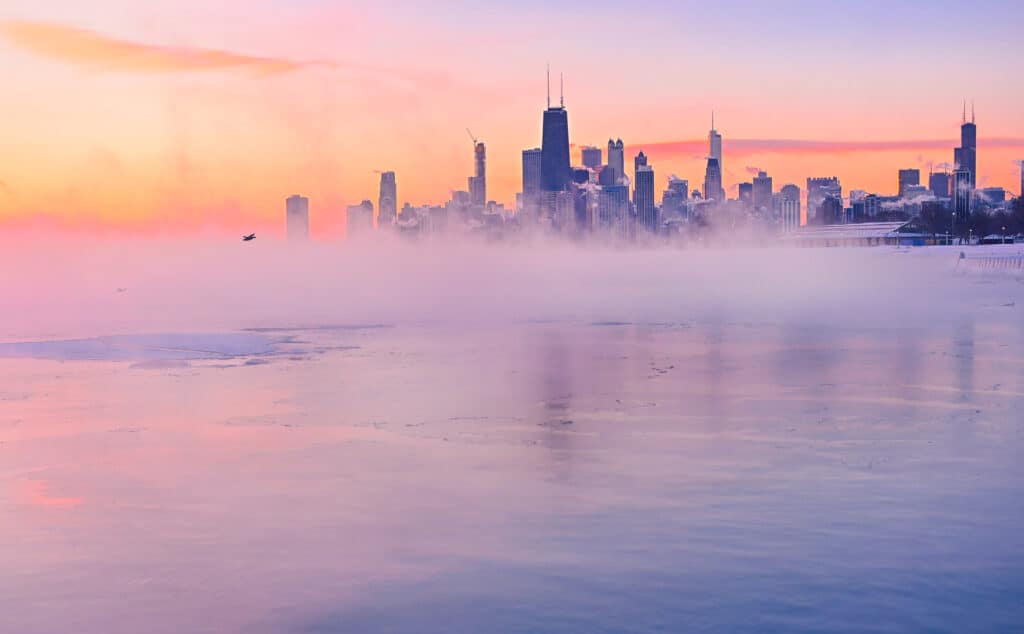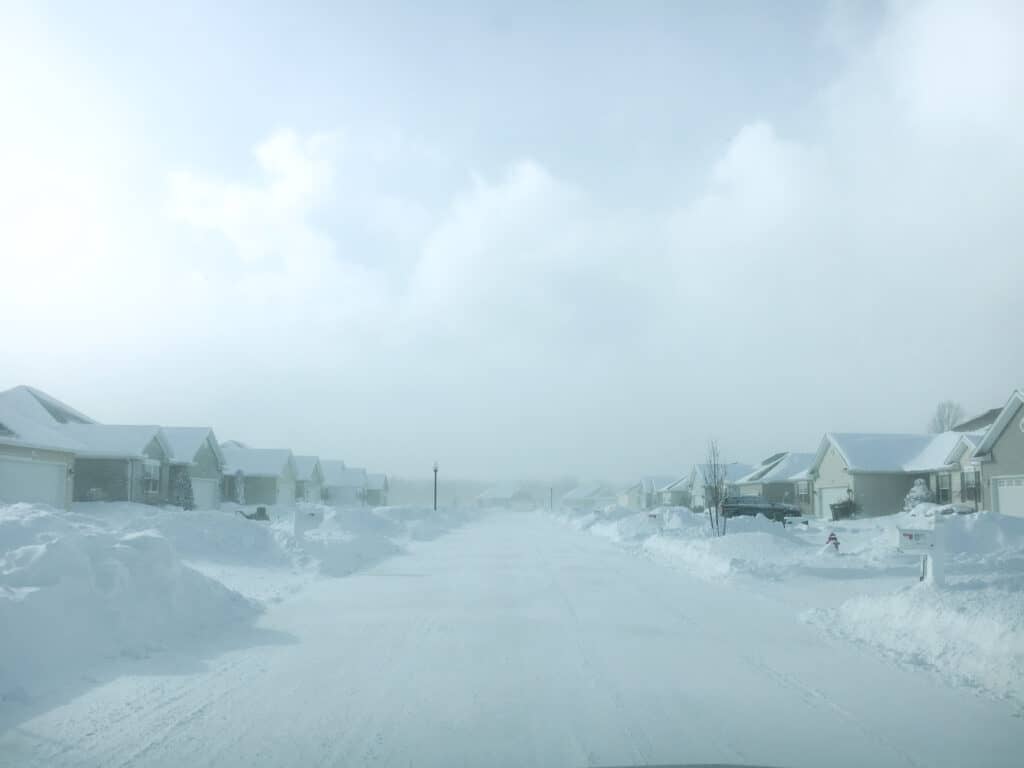The term polar vortex might sound like it belongs in an icy science fiction novel, but it is actually a very real weather phenomenon. It may seem like the term polar vortex just popped up in the past few years, however, the situation is nothing new.
It’s simply that the term has become more popular to use for weather reports in recent years. Often, during a polar vortex, an area of the earth experiences extremely cold temperatures. However, that is not the only reason for colder than normal temperatures.
What Causes a Polar Vortex?
A polar vortex is an area of cold, low-pressure air. It always exists at both the north and south poles. It is called a vortex because a swirling flow of air going counterclockwise typically keeps the cold air close to the poles. In the north, this airflow is called the Polar Jet Stream.
Sometimes, in the northern hemisphere in the winter, this jet stream becomes disrupted and allows the air to go south, sending unusually cold temperatures to North America, Europe, and Asia, basically anywhere in the Northern Hemisphere.
A polar vortex can reach as far south as Texas, Northern Mexico, and Florida.
A similar effect can take place in the Southern Hemisphere. In Australia, Antarctic polar vortexes are called a “polar blast.”
What Are the Effects of a Polar Vortex?
So, you’ve heard the weather report: a polar vortex is coming. What does that really mean? During a polar vortex, temperatures will be colder than normal, and not by just a few degrees. In the February 2021 North American cold wave, temperatures were significantly below average all across the country, but in Texas, they were 50 degrees below average. Snow not only fell but also accumulated in Texas, a place that rarely sees snowfall. These cold snaps can last for up to a month in some cases.

Polar vortexes bring temperatures that are colder than usual.
©Jake Hukee/Shutterstock.com
How to Prepare for a Polar Vortex?
If the weather says there will be a polar vortex and you live in an area that isn’t usually very cold, be prepared with these tips:
- Keep plenty of extra blankets or sleeping bags at home and in your car.
- Get warmers you can stick in gloves and shoes.
- Wear warm layers and remove any clothing as soon as it gets wet.
- Use supplemental heating devices generators safely. Always read the instructions to avoid CO2 poisoning.
- Keep cat litter or sand on hand to make icy walkways safer.
- Set your faucets to drip to keep water flowing to prevent burst pipes.
- If possible, wrap pipes in layers of newspaper and plastic before the cold weather for insulation. It’s better to do proper pipe insulation before a cold snap, but in an emergency, newspaper can help.
- Open cabinets to let more heat into the pipes.
- Keep extra water on hand in case pipes do freeze.
- Shut off water in case of a burst pipe.
- Close off rooms you are not using to keep heat in one area of the house.
- Wear a hat to avoid losing body heat from your head.
- Eat plenty of food to give your body enough energy to stay warm.
- Keep your gas tank near full so you will be able to stay warm if you get stuck somewhere.
Notorious Artic Polar Vortexes
There have been several famous polar vortexes in the past few years. While a cold snap may not seem like a big deal, it can be deadly and cause millions or even billions of dollars of damage.
February 2021 North American Cold Wave
In 2021 a devastating polar vortex caused extremely unusual temperatures all across the United States and into Northern Mexico. The state of Texas was the most severely affected. Their power grid essentially failed and left millions without power during extremely cold weather that many had not experienced before, and many were not prepared for. Much of the power equipment in the state was not winterized, so it could not operate under the extreme record-setting temperatures. More than 275 died as a result of this cold wave. Damages in the US were about $2 billion and in Mexico, they were about $1.5 billion. At the Dallas Fort-Worth Airport, a record low temperature of -2 degrees Fahrenheit was recorded.
Early 2014 North American Cold Wave
In early 2014, a cold wave happened that was so powerful it reduced the GDP of the United States by 2.9%. It started on January 2 of that year, when a Noreaster storm and a polar vortex occurred at the same time. This resulted in cold temperatures and heavy snow and heavy winds. The cold and wind stayed until March, affecting more than 200 million people between the Rocky Mountains and the Atlantic Ocean in the US and Canada. Multiple record temperatures were hit during this cold snap:
- -18 degrees Fahrenheit in Green Bay, Wisconsin
- -14 degrees Fahrenheit in Detroit, Michigan
- -9 degrees Fahrenheit in Pittsburgh, Pennsylvania
- 6 degrees Fahrenheit in Atlanta, Georgia
This weather affected the economy severely because of business shutdowns, slowed construction, and low home and car sales. Schools were closed often, so many parents could not work as much. A total of 20,000 flights were canceled over those few months.

This suburban neighborhood is buried in snow due to a blizzard resulting from a polar vortex.
©eyerazor/Shutterstock.com
2018 British Isles Cold Wave
In 2018 a polar vortex hit the British Isles including the UK and Ireland. It came at the same time as an anticyclone, a type of storm that more typically brings calm weather. However, in this case, it brought heavy snowfall due to the lake effect along with the cold air that was coming in from the Siberian region. The cold snap started on February 22, 2018, and lasted until mid-March.
Over 90 people died during the event in 19 countries including Italy, Romania, and Poland. Causes of death included traffic accidents, slipping on ice, and exposure. The storm and polar vortex were given the nickname “Beast from the East” due to the fact that the cold air was coming from Siberia.
What Else Causes Cold Waves?
Another weather pattern that can cause cold waves is La Niña. This weather pattern tends to make winters colder and wetter in some areas of the northern hemisphere, like Canada, the Rocky Mountains, and Northern California. However, in other places, like Southern California, it makes winters even drier.
Up Next:
- The 5 Deadliest Blizzards of All Time
- How do Blizzards Form, and Why are They so Dangerous?
- How Cold is Too Cold For a Chicken to Stay Outside? How Hot is Too Hot?
- Discover the Wettest Country on Earth
The photo featured at the top of this post is © Sambulov Yevgeniy/Shutterstock.com
Sources
- Wikipedia, Available here: https://en.wikipedia.org/wiki/2018_British_Isles_cold_wave
- Wikipedia, Available here: https://en.wikipedia.org/wiki/Early_2014_North_American_cold_wave
- Wikipedia, Available here: https://en.wikipedia.org/wiki/February_2021_North_American_cold_wave
- Texas Tribune, Available here: https://www.texastribune.org/series/winter-storm-power-outage/
- Wikipedia, Available here: https://en.wikipedia.org/wiki/Polar_vortex
- Wikipedia, Available here: https://en.wikipedia.org/wiki/La_Ni%C3%B1a
Thank you for reading! Have some feedback for us? Contact the AZ Animals editorial team.






